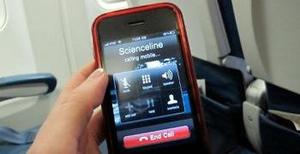Aviation securityCargo bomb aftermath: end for in-flight cellular, Wi-Fi connection
The aviation industry is gearing up to provide broadband in-flight entertainment systems that feature both cell phone and Wi-Fi connections for passengers; in-flight communications is a fast-growing market at the moment — but the discovery last week of the cargo bomb plot now casts doubt on the wisdom of in-flight communications; we now know that the cell phones in the printer bombs were not intended to be triggered remotely, and were intended simply as timers, as in the 2004 Madrid train bombings; future devices, though, could take advantage of wireless communication, meaning that on-board bombs could be triggered remotely, from the ground, by a cell phone

This is something you won't see on a flight // Source: scienceline.org
The long-awaited ability to use a cell phone or Wi-Fi connection on an aircraft may well become a casualty of the latest aviation security threat.
It was revealed on 29 October that parcels containing a powdered explosive packed in laser printer cartridges had traveled undetected on aircraft to the United Kingdom and to Dubai in the UAE. A cell phone connected to a detonation circuit could have allowed a terrorist to trigger an explosion by calling or texting the phone.
Paul Marks writes in New Scientist that this comes as the aviation industry is gearing up to provide broadband in-flight entertainment systems that feature both cell phone and Wi-Fi connections for passengers. These systems would mean that passengers would no longer need to use their cell phones illicitly when they come into range of ground masts at low altitudes near airports — a potentially dangerous activity that could interfere with the aircraft’s avionics.
Marks notes that in-flight communications is a fast-growing market at the moment. Market researcher InStat of Scottsdale, Arizona, says that 2000 passenger aircraft are expected to have this kind of satellite broadband communications technology by the end of this year, compared with just “a couple of dozen” in 2008.
Last week’s cargo bomb discoveries cast doubt on the wisdom of in-flight communications, says Roland Alford, managing director of Alford Technologies, an explosives consultancy in Chippenham, Wiltshire, United Kingdom. He says he expects the technology to be scrutinized in the security reviews being undertaken by the U.K. government and U.S. DHS in the wake of the discovery of the printer bombs.
The U.K. Department of Transport would not confirm whether the issue would in fact be on its agenda.
We now know that cell phones in the printer bombs were intended simply as timers, as in the 2004 Madrid train bombings. Future devices, though, could take advantage of wireless communication.
In-flight Wi-Fi “gives a bomber lots of options for contacting a device on an aircraft,” Alford says. Even if ordinary cell phone connections are blocked, it would allow a voice-over-internet connection to reach a handset.
“If it were to be possible to transmit directly from the ground to a plane over the sea, that would be scary,” says Alford’s colleague, company founder Sidney Alford. “Or if a passenger could use a cell phone to transmit to the hold of the airplane he is in, he could become a very effective suicide bomber.”
Marks writes that manufacturers of the technologies will not welcome this fresh security concern, having finally gained airworthiness approval for their in-flight cell phone and Wi-Fi systems by proving that their microwave transmissions do not interfere with avionics.
“There are many ways of coordinating an attack without using a mobile phone,” says Aurélie Branchereau-Giles of OnAir, a company based in Geneva, Switzerland, that Airbus is backing as a maker of in-flight cellphone and Wi-Fi systems. “The position of our security experts is that the use of mobile phones on planes does not constitute any additional security threat.”
